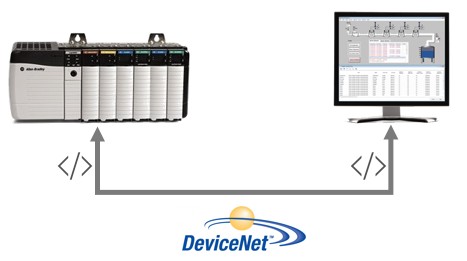NI OPC Technologies
Overview
Contents
NI OPC Servers
The NI OPC Servers software acts as a bridge to convert proprietary industrial protocols to the open OPC Classic and OPC UA protocols. This conversion to OPC then enables LabVIEW software to communicate to many different programmable logic controllers (PLCs) and third-party devices through the OPC Classic client that is included with the LabVIEW Datalogging and Supervisory Control (DSC) Module. Additionally, NI OPC Servers can connect to LabVIEW OPC UA clients created with the LabVIEW OPC UA Toolkit. The combination of NI OPC Servers and LabVIEW provides a single solution for delivering high-performance measurements and control to industrial systems.
Figure 1: NI OPC Servers works as a bridge to translate between proprietary industrial protocols and OPC Classic or/and OPC UA.
NI OPC Servers includes 100+ drivers to connect to devices from third-party vendors. For a comprehensive list of supported devices, review Supported Device and Driver Plug-In List for NI OPC Servers.
NI OPC Servers can connect to NI OPC clients only. NI OPC clients can be implemented through the LabVIEW DSC Module or with the Lookout SCADA software.
NI OPC Servers includes two distinct licensing models:
• One Simultaneous Driver Usage—Allows connection to one driver at a time on the computer hosting the NI OPC Servers. Buy one-driver license
• Unlimited Simultaneous Driver Usage—Allows connection to an unlimited number of drivers simultaneously on the computer hosting the NI OPC Servers. Buy an unlimited driver usage license
LabVIEW OPC UA Toolkit
The LabVIEW OPC UA Toolkit allows integration of secure, reliable communications in your LabVIEW applications. This toolkit allows communications and interoperability with third-party devices and supervisory systems supporting the OPC UA specification. It incorporates a series of features for the creation of OPC UA clients, servers, and security management. In addition to the data access (DA) facet of the protocol, the LabVIEW OPC UA Toolkit includes support for the historical access (HA) and alarms and conditions (AC) facets. The HA facet allows the creation, retrieval, update, and deletion of archived data. The AC facet allows the definition, management, and acknowledgement of state-driven notifications that require interaction with an operator or a user such as infringement of safety limits, maintenance service, or confirmation of steps in a process. The LabVIEW OPC UA Toolkit is compatible with both Windows and NI Linux Real-Time OSs.
The LabVIEW OPC UA Toolkit also allows communication with any third-party device or supervisory software fully supporting the OPC UA specification.
Figure 2: The LabVIEW OPC UA Toolkit allows interoperability with third-party devices that support the OPC UA specification.
For Windows-based applications, development requires the LabVIEW OPC UA Toolkit and deployment requires the LabVIEW Application Builder Module and the LabVIEW OPC UA Toolkit Deployment License.
For applications based on NI Linux Real-Time, development requires the LabVIEW Real-Time Module and the LabVIEW OPC UA Toolkit; however, no deployment license is required.

